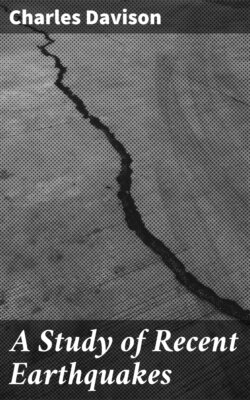Читать книгу A Study of Recent Earthquakes - Charles Davison - Страница 7
На сайте Литреса книга снята с продажи.
TERMS AND DEFINITIONS.
ОглавлениеSome terms are of such frequent use in describing earthquakes that it will be convenient to group them here for reference, others more rarely employed being introduced as they are required.
An earthquake is caused by a sudden displacement of the material which composes the earth's interior. The displacement gives rise to series of waves, which are propagated outwards in all directions, and which, when they reach the surface, produce the sensations known to us as those of an earthquake.
The region within which the displacement occurs is sometimes called the hypocentre, but more frequently the seismic focus or simply the focus. The portion of the earth's surface which is vertically above the seismic focus is called the epicentre. The focus and epicentre are often spoken of for convenience as if they were points, and they may then be regarded as the centres of the region and area in which the intensity was greatest. This is not quite accurate, but to attempt a more exact definition would at present be out of place.
An isoseismal line is a curve which passes through all points at which the intensity of the shock was the same. It is but rarely that the absolute intensity at any point of an isoseismal line can be ascertained, and only one example is given in this volume. As a rule, the intensity of a shock is determined by reference to the degrees of different arbitrary scales. These will be quoted when required.
Fig. 1.—Diagram to illustrate simple harmonic motion.ToList
In every strong earthquake there is a central district which differs in a marked manner from that outside in the far greater strength and complexity of the phenomena. As this district includes the epicentre, it is sometimes referred to as the epicentral area, but the term meizoseismal area is more appropriate, and will be employed accordingly.
The district over which an earthquake is perceptible to human beings without instrumental aid is its disturbed area. In like manner, that over which the earthquake-sound is heard is the sound-area.
A great earthquake never occurs alone. It is merely the most prominent member of a group of shocks of greater or less intensity, and is known as the principal shock or earthquake, while the others are called minor or accessory shocks, and fore-shocks or after-shocks according as they occur before or after the principal earthquake. When the sound only is heard, without an accompanying tremor being anywhere perceptible, it is more accurately called an earth-sound, but is frequently for convenience numbered among the minor shocks.
The movement of the ground during a vibration of the simplest character (known as simple harmonic motion) is represented in Fig. 1. The pointer of the recording seismograph is here supposed to oscillate along a line at right angles to AB, and the smoked paper or glass on which the record is made to travel to the left. The distance MP of the crest P of any wave from the line AB represents the amplitude of the vibration, the sum of the distances MP and NQ its range, and the length AB the period of the vibration. From the amplitude and period we can calculate, in the case of simple harmonic motion, both the maximum velocity and maximum acceleration of the vibrating particles of the ground.[1]
A few terms describing the nature of the shock are also in common use among Italians and Spaniards. An undulatory shock consists of one or several waves, the movement to and fro being along a nearly horizontal line; a subsultory shock of movements in a nearly vertical direction; while a vorticose shock consists of undulatory or subsultory movements crossing one another in different directions.
